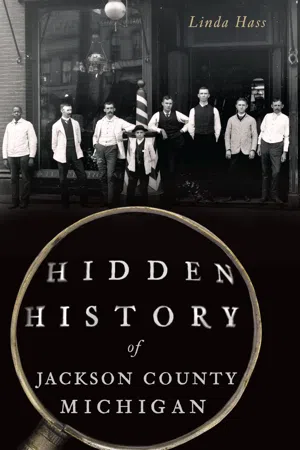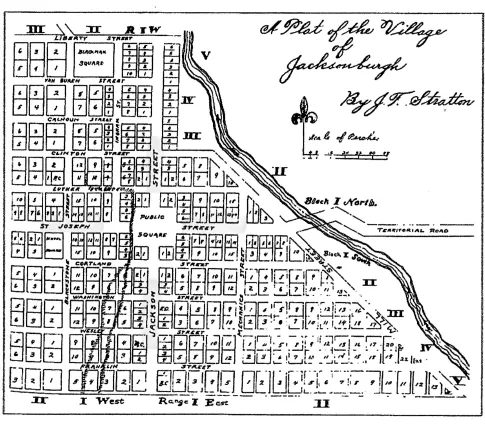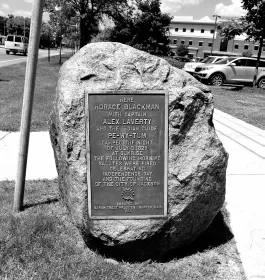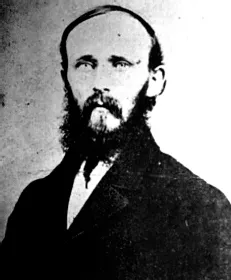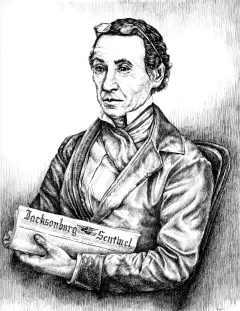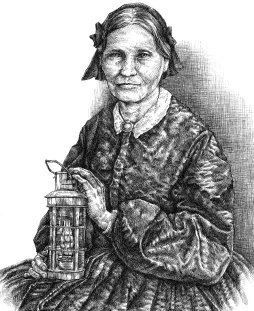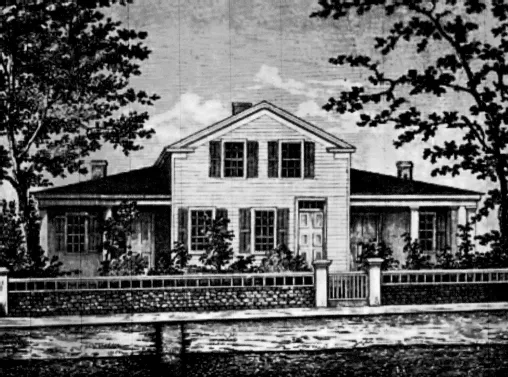![]()
Part I
EARLY JACKSON
The plat of the Village of Jacksonburgh revolves around the public square, Jackson’s historic center. Courtesy Jackson District Library.
![]()
1
PEWYTUM AND THE WASHTENONG SEPE
Most Jackson residents have heard of Horace Blackman (1801–1850), the town’s celebrated founder. They may not know, however, that long before Blackman arrived, the place they call “home” had been home to Native Americans who helped make Blackman’s claim possible.
Hints of this heritage exist on a bronze plaque at the intersection of West Trail and North Jackson Streets. The memorial, affixed to a large rock, shows where “Horace Blackman, with Captain Alex Laverty and the Indian guide Pe-wy-tum camped the night of July 3, 1829.” This date, according to the plaque, marks “the founding of the City of Jackson.”
Between the lines on the plaque is an intriguing backstory marked by the convergence of Native American trails and indigenous people in a landscape filled with rippling blue streams, verdant forests, silvery birch and plentiful game. It is a story too long to fit on a marker but too fascinating to ignore.
The tale begins with a prospective settler from New York named Horace Blackman, who read mixed reviews about the beguiling Michigan Territory. Some reports condemned the area as a thinly populated wasteland. Others praised its benefits, including streams that could sustain mills and fertile land ripe for crops. Which report was true? The curious explorer decided to see for himself. Blackman hired Alexander Laverty, an experienced woodsman, and Pewytum, a Native American guide, to lead him to a remote location in the south-central part of what would become the state of Michigan.
Heading out from the frontier hamlet of Ann Arbor (the farthest western outpost from Detroit at the time), the adventurers reached their destination after a hot, two-day hike. Their target was the east bank of a river that Native Americans called the Washtenong Sepe, or “clear, swift stream running over a bed of pebbles.” Today, this stream is known by its shorter and less descriptive name: the Grand River. The men forded the stream approximately where Trail Street crosses the river and camped the night of July 3 on the west bank near what is now downtown Jackson.
Jackson founder Horace Blackman first camped in this spot (West Trail and North Jackson Streets) in 1829. Author’s photo.
In 1829, Horace Blackman registered a claim for 160 acres in what would become Jackson at two dollars per acre. Courtesy Jackson District Library.
The next day, the Fourth of July, the threesome awoke from their riverbank encampment to survey the land before them. The misty morning light illuminated Native American cornfields to the north, confirming the soil’s fruitfulness. To the south were dense forests that could supply lumber for building and fuel. To top it off, a drinkable stream gurgled under their noses. Blackman discovered another asset not mentioned in any report: several trails intersected the river, suggesting the area’s potential as a major trading thoroughfare.
Blackman decided that his firsthand impressions confirmed the positive reports. This was the place the plucky pioneer would call home. The men feted the occasion with an impromptu celebration. Traces of their celebration are long gone, but if nature could replay the sights and sounds it has absorbed over the millennia, curious ears would hear a rousing rifle salute that echoed far and wide. They would also hear the first bilingual speech ever uttered in Jackson. Laverty honored the occasion with discourse in Potawatomie, the language of the dominant indigenous group, and in English.
Afterward, the men toasted the day with a cool drink of water from the Washtenong Sepe. Pewytum capped off the ceremony with one last rifle shot. The gunfire attracted curious natives who came to see what the commotion was all about. The two groups ended up celebrating the occasion with a feast of game, potatoes, fresh fish and roasted corn.
Blackman returned to Ann Arbor and then walked to Monroe, where he registered his claim for 160 acres in what is now Jackson, at two dollars per acre. On February 6, 1831, Governor Lewis Cass fulfilled Blackman’s hopes by declaring “Jacksonburg” the county seat. Thus began the chain of events that would lead to the growth and development of Jackson County.
Helping to make these milestones possible were indigenous trails leading to this spot in 1829; the Native American Pewytum, who guided explorers here; and a first-ever celebratory feast uniting Native Americans and Jackson’s adventuresome founder—facts long forgotten but fascinating, nonetheless.
FUN FACTS
• Horace and his brother Russel Blackman cleared their new property and built the first log cabin ever erected in Jackson on the corner of what is now Ingham and Trail Streets.
• In 1830, Blackman’s claim was named Jacksonburg in honor of then-president Andrew Jackson. Postal officials changed the name to Jacksonopolis to avoid confusion with other Jacksonburgs. In 1838, townspeople shortened the name to Jackson. The Village of Jackson was incorporated in 1843. In 1857, Jackson became a city.
• In 1847, Jackson was a contender for the state capitol, which was then located in Detroit. Ultimately, legislators chose Lansing (which at the time had only a dam and one log cabin) over Jackson, which was a bustling town of about three thousand and the fourth largest in the state.
• Dominant industries in Jackson in the nineteenth century included coal mining, corset making and railroading. Local car companies included the Briscoe Motor Company and Jackson Automobile Company, which produced the Jaxon steam car.1
![]()
2
THE INVISIBLE PATRIARCH
There is no park, statue or township named after Jackson pioneer William R. DeLand (1794–1876). But this unsung hero did more to promote Jackson’s earliest growth than any other individual, making him a vital, if invisible, mover and shaker in Jackson’s development.
William was among the first settlers to occupy the original log cabin built in Jackson. He was also among the first surveyors of the area, the first justice of the peace and the force behind a Jackson publishing dynasty. In addition, he cofounded one of Jackson’s earliest churches, and he and his wife, Mary DeLand, were leading participants in the Underground Railroad, a secret network that transported enslaved Americans from the South to the North in the early to mid-1800s.
Oddly, these contributions are little acknowledged today. While his cousin, Horace Blackman, has a township and a park named after him (even though Blackman left the village of Jackson after six years), no such honor has ever been bestowed on William, who remained in Jackson for the rest of his life to help the town grow and prosper. It is a strange epitaph for a patriarch who contributed so much.
William’s story begins in North Brookfield, Massachusetts, where he and Mary lived and where he worked as a schoolteacher. He was well established in the town, but he had an adventurous heart. When cousin Horace asked if he would be willing to move to the untamed wilderness of the Michigan Territory, he listened with an open mind.
William, a visionary who always seemed to be on the cutting edge of trends, saw the potential of such a move. He had witnessed the beauty and bounty of Michigan firsthand when he joined a surveying party that came to this state before Blackman and his band of explorers ever set foot in the area. He had seen the rolling landscapes carpeted in green, waded through the cool, fresh streams and heard the howling wildlife—a testament to plentiful game. With that positive experience in mind, William accepted his cousin’s offer.
William DeLand founded Jackson’s first newspaper, the Jacksonburg Sentinel, among other contributions. Sketch by Brianne Witt, assistant art professor, Spring Arbor University, courtesy Linda Hass.
Mary DeLand influenced her family to participate in the Underground Railroad. Sketch by Brianne Witt, assistant art professor, Spring Arbor University, courtesy Linda Hass.
On April 14, 1830, seven years before Michigan became a state, William, Mary and their two small children loaded their possessions in a covered wagon, painted the word Michigan on the wagon’s side and lumbered west, traveling forty miles a day. On Sunday, May 28, the wagon reached its destination.
Women and men perceived their new home quite differently, with the men gravitating toward a flattering description, calling it a “goodly land, flowing with milk and wild honey, and plenty of venison into the bargain.” The women were less than amused at their first accommodations, a rough-hewn log cabin with a dirt floor and one large room that was shared communally. That first night, Mary and the other women dutifully prepared and served the first meal and then these refined ladies went out behind the house and had a “good cry.”
The DeLand homestead was a safe house in Jackson’s Underground Railroad. Courtesy Burton Historical Collection, Detroit Public Library.
As Jackson developed, William rose quickly through the ranks and was appointed justice of the peace. He was elected county clerk and later probate judge, an office he held for eight years. With these positions came prosperity and a larger home on the northeast corner of Mechanic and Franklin Streets. The stately white home with covered porches served as a station on the Underground Railroad for many years. It also served as a silent witness to the tender hearts of a couple who felt a deep responsibility to help the enslaved.
After decades of guiding Jackson’s growth and development, William died on November 26, 1876, and was buried at Jackson’s Mt. Evergreen Cemetery. His obituary stated, “He was one of the first to carry the surveyor’s chain… wrote the first notice…rendered the first decision in law, and formed the first religious society here.”
Unfortunately, he is rarely, if ever, credited when village founders are honored. His name, however, is briefly listed among Underground Railroad activists on a Michigan historical marker in Mt. Evergreen Cemetery. Nearby, the inscription on his family’s granite grave monument proclaims that the DeLands were a “Pioneer Family of Jackson.” What it does not proclaim is equally true: this pioneer stood out among Jackson’s patriarchs. He may be unfamiliar today, but he was indispensable to the founding of the town Jacksonians call home.2
![]()
3
JACKSON’S RADICAL NEWSPAPERS
By 1837, Jacksonburg boasted a post office, a courthouse, a primitive schoolhouse and a cluster of businesses. One thing the rustic village lacked was a newspaper. To remedy this glaring omission and to help bring civilization to the small burg, William DeLand and Norman Allen led the charge in recruiting a printer and a press. Their quest resulted in a Vermont printer, Nicholas Sullivan, moving to Jackson and setting up shop in the public square. One of the reasons that Nicholas moved was because his brother, Reverend William Sullivan, who lived in Jacksonburg, offered to help him in the venture. The fruit of their labor was the village’s first newspaper, the Jacksonburg Sentinel, first printed in 1837. The Ramage press provided by the village was previously used by Michigan’s first newspaper, the Detroit Gazette.
JACKSONBURG SENTINEL
The Jacksonburg Sentinel was generally published on Saturdays, beginning in 1837. Its office was on the second floor of a ramshackle wooden building “at the northeast corner of Jackson Street and the public square.” (Today Bucky Harris Park.) A yearly subscription cost two d...
